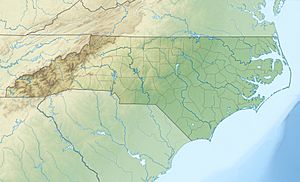Fall Creek (Cape Fear River tributary) facts for kids
Quick facts for kids Fall Creek |
|
|---|---|
|
Location of Fall Creek Creek mouth
|
|
| Other name(s) | Tributary to Cape Fear River |
| Country | United States |
| State | North Carolina |
| County | Lee |
| Physical characteristics | |
| Main source | Patchet Creek divide pond about 0.25 miles northwest of Broadway, North Carolina 465 ft (142 m) 35°28′06″N 079°03′45″W / 35.46833°N 79.06250°W |
| River mouth | Cape Fear River about 4 miles south of Corinth, North Carolina 147 ft (45 m) 35°31′54″N 078°58′55″W / 35.53167°N 78.98194°W |
| Length | 7.98 mi (12.84 km) |
| Basin features | |
| Progression | northeast |
| River system | Cape Fear River |
| Basin size | 8.77 square miles (22.7 km2) |
| Tributaries |
|
| Bridges | Salem Church Road, Copeland Road, Buckhorn Road |
Fall Creek is a small stream located in Lee County, North Carolina. It flows for about 7.98 miles (12.84 kilometers). Fall Creek is a "tributary," which means it is a smaller stream that flows into a larger river. In this case, it flows into the Cape Fear River.
Contents
Where Fall Creek Flows
Fall Creek begins its journey in a pond. This pond is located about 0.25 miles (0.40 kilometers) northwest of a town called Broadway, North Carolina.
From its starting point, Fall Creek flows mostly towards the northeast. It continues its path until it reaches the Cape Fear River. This meeting point is about 4 miles (6.4 kilometers) south of Corinth, North Carolina.
Understanding the Fall Creek Watershed
A "watershed" is an area of land where all the water drains into a single river, lake, or ocean. The Fall Creek watershed is the entire area of land that collects water and sends it into Fall Creek.
Size of the Watershed
The Fall Creek watershed covers an area of about 8.77 square miles (22.7 square kilometers). This means that all the rain and other water that falls within this area will eventually flow into Fall Creek.
Rain and Forests
The Fall Creek watershed receives about 47.5 inches (121 centimeters) of rain each year. A large part of this area, about 57%, is covered by forests. Forests are very important for a watershed because they help to filter the water and prevent soil from washing away.



